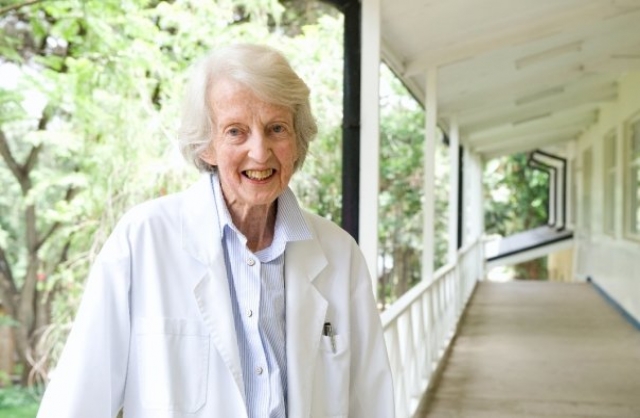
Dr. Catherine Hamlin is an Australian gynaecologist who has spent most of her life in Ethiopia. A recipient of numerous awards, Catherine has revolutionized care of a childbirth injury called obstetric fistula, which occurs when the baby gets stuck in the birth canal and there is no doctor to perform a cesarean section. Dr. Hamlin and her late husband, Dr. Reginald Hamlin, founded the fistula hospital in Addis Ababa, Ethiopia, the world’s only medical center dedicated exclusively to providing free obstetric fistula repair surgery to poor women suffering from childbirth injuries.
You have been recognized as a pioneer in fistula surgery and have dedicated yourself to giving women in Ethiopia a second chance at life. At 91, you are still going strong. What brought you to Ethiopia and why fistula surgery?
We wanted to work in a developing country needing doctors before we returned to settle in Australia eventually. So we responded to an advertisement in the Lancet medical journal for a gynaecologist to work in Ethiopia and were both accepted to spend 3-4 years there working at the “Princess Tsehai Memorial Hospital” set up by the Emperor Haile Selassie in memory of his daughter, Princess Tsehai, trained in England as a nurse. She died in childbirth when married to the Governor of Welega, a distant western province with little medical help for somebody in obstructed labour. So the emperor called the hospital after his daughter. This was when we worked for many years and when we met many women arriving with an “obstetric fistula” – leaking urine and sometimes bowel contents as well. The 10 free beds at the hospital were used for such patients.

Catherine with her husband Dr. Reginald Hamlin
You, your husband, Dr. Reginald Hamlin, and the hospital’s medical staff have treated more than 45,000 women for obstetric fistula (in 55 years). What were some of the challenges you faced in Ethiopia and how did you overcome them?
One of our main challenges was that the Princess Tsehai hospital was not a free hospital and the 10-bed ward we were given, with free beds, were not enough for the numbers arriving in the outpatient department. So we decided to build our own hospital for fistula-injured women (some still young girls) as a free hospital.
After getting permission as foreigners to do this and finding a suitable and attractive piece of land we built our fistula hospital for women and girls. Some of these patients stayed on and are now skilled helpers at our hospital. The government was kind in allowing us to do this work and continued to pay our salaries. This was a great help to us.
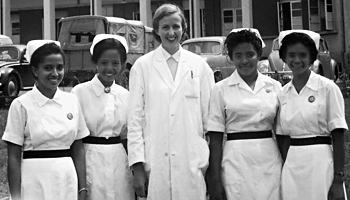
Catherine and the midwives
We asked to buy some land and were offered a site owned by the Emperor’s daughter. However, as the royal land was too far from the bus stops where the patients would arrive from the country, we had to politely decline and instead asked to buy in a different area. We eventually secured a triangular area bounded by the Akaki River on one side and a quiet shirt factory on the other. The third side abutted a quarry edge, with a big drop, so we had to secure that boundary with adequate fencing. We funded the build with donations from our Australian and New Zealand relatives and friends, with a significant lump sum amount from CORSO, the New Zealand overseas aid organization at that time.
Tell us more about obstetric fistula. How does it impact women and why are they stigmatized? How much does a surgery cost to fix the problem?
An obstetric fistula is caused often when the labour is obstructed and goes on for some days. It is just a wearing out by pressure of a baby’s head trying to get born: pressure of the head on the bladder in front and the rectum behind. Bladder pressure is the most common, causing a hole to develop and a consequent death of the bladder wall in the area of pressure. Urine leaks out uncontrollably. This causes continuous incontinence of urine and can involve the rectum as well, making the plight of a woman an awful one. But most injuries can be surgically cured. There are degrees of injury to the bladder and sometimes the rectum as well which can be mostly cured through surgery, unless too much bladder is destroyed – then other procedures can be tried, to restore continence.
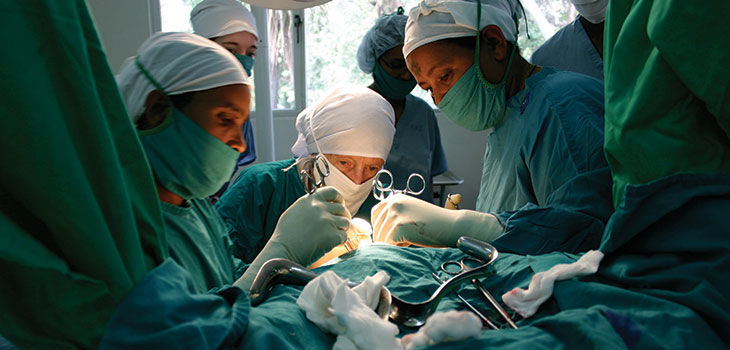
Dr. Catherine performing a surgery
The two main causes of obstructed labour are either the baby, as the ‘passenger’ in the birth process, is too large or in the wrong position or else the passage, that is the pelvic bones, are too close together or are the wrong shape to allow the baby to pass through.
- 1. If the baby is lying in the uterus in such a position that it cannot be born, then the position can be corrected by a gynaecologist or a trained nurse
- 2. With the ‘passage problem’ the pelvic bones can be distorted by disease or genetics or are too small due to malnutrition. Being a child bride in early teens is an additional cause of a small pelvis. All these reasons for an obstructed labour will need skilled help to deliver by forceps or Caesarean section. (The Government in Ethiopia is working to discourage child marriage as a contributor to obstructed labour: child marriage is now illegal).
Stigmatization of fistula patients is simply connected to the offensive odour that urinary and faecal incontinence imposes: this drives the sufferer into isolation. The fact that in the past it was considered incurable lead to a secondary superstitious spiritual stigma: that the sufferer had committed a sin so grave that God had cursed them. We work medically against the first stigma and spiritually and psychologically against the second – and we are successful.
In our rural centres the cost of cure of a patient, which takes at least three weeks hospital admission and an operation, is about US$700, a bit more in our Addis Ababa centre where the more complicated cases arrive.
One of the most notable features of your work is the way you have empowered recovering fistula patients to help in the treatment of others. Please share with our readers some of your success stories.
We had many girls and young women who when repaired wished to stay on and be trained as “nursing aids” and they eventually became the backbone of our nursing staff as nearly all have great empathy with the injured patients, having been through the same experience. So they show kindness and understanding to others. Some have been with me for many years and a few even before my husband Reg Hamlin died in 1993 so have grown up with the hospital and it has become their home. Many are on a salary and may have built their own homes and even got married. A very few have children of their own but most were so damaged in their first “obstructed labour” that they are unable to marry and have a family of their own. But all are able to build their own homes in the vicinity and come daily for work and are happy to help others. Most are happy.

Catherine with the hospital staff
What would you tell your 16 year old self?
I have had such an exciting and eventful life that it is quite difficult now to reflect on those teen years. I think looking back that I would say to myself then that it is surprising what can be changed in this world, if your eyes are open to the need and opportunity. My husband and I were really pioneers of an injury that previously was considered to be irreparable because it was in a fairly inaccessible and private place in a ‘bodily tube’, the vagina. I do not know now if the job I did would appeal now to young medical students. There is such new scope for exciting work and this is really a need that with all the preventative care now coming to the fore, there is less of a need for an operative intervention. Only in countries that are short of trained doctors and midwives do such fistula injuries still exists.
Any unachieved goals or unfulfilled wishes you are still working on?
I am really retired from any clinical work, as will soon be 92 years old. I of course have wishes that one day our hospitals (6 altogether in Ethiopia) will no longer be needed and can be converted to maternity hospitals as we shall have enough trained doctors to staff all our remote hospitals in the countryside, now run by health officers. So our doctors need to be motivated to stay in their own country and help the remote population get good medical care. At present most of the remote sites, if they are running, are staffed by single-handed missionary doctors. We are losing many of our own for a so-called better life elsewhere. This is sad!
Your secret to a healthy mind and body?
To have a love of life, your job, your family, your country and your God. And to be satisfied with what you do so that your work is not a burden and your regrets too great. I do not think I always have a feeling of joy, but mostly I do, when I see the state of so many others in such terrible situations and realize how wonderful it is to be living in a peaceful and beautiful country whether it is England, Australia or Ethiopia.
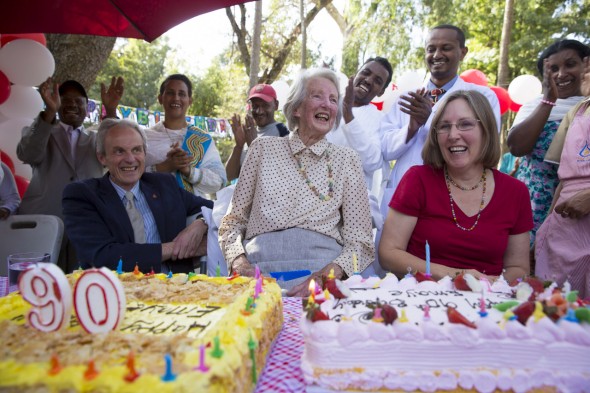
At her 90th birthday. Photograph by Joni Kabana Photography
What is your idea of an empowered woman?
Just somebody who loves what she is doing in life. I think you can only be empowered if you enjoy your work, your family and life. I feel happy that I am still alive at almost 92 years old.
Sayfty’s mission is to Educate, Equip and Empower women so that they can protect themselves against violence. What is your message for our readers related to women’s personal safety and the issue of violence against women?
I have not come across the issue of violence against women, but only know that women and girls with an untreated vaginal fistula injury often become social outcasts because of their incontinence and thus an offence to others, so are often reduced to great poverty. But I do not think and have certainly not heard of any violence against these patients. I know that many will try and separate themselves from society. Some will try and some will succeed in committing suicide. One even in our hospital hung herself with a cord. This was some years ago, but is still vivid in my memory. From my work perspective, giving women and girls their self worth and their health back ‘automatically’ equips them against prejudice and perhaps against violence.
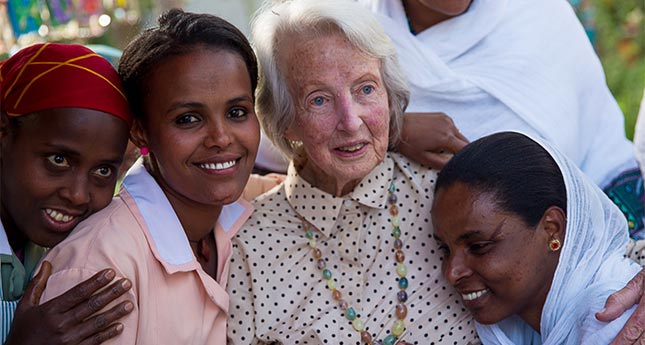
Another one from her birthday
In my work and in my time in Ethiopia, as I said above, I have not often come across violence specifically against women. I am aware of the importance of women in peasant society and in Ethiopian society in general. However, child marriage was a problem, as I mentioned above and is now illegal. However, the more remote areas of the country will need time to change their customs. FGM is much less common than in some African countries and is not usually a cause of fistula injury.
Finally, is there anything else you wish to share with our readers?
I think you’ve heard enough from me! But I finish by saying that I have mostly always been happy with what I have done working for women and being able to restore so many to a normal life again. Always working with like-minded and wonderful colleagues, but without these and specially my husband and now my son, Richard Hamlin, who has always been so supportive and helpful I could not have done anything like what we have achieved together. I know I worship a God of love and it is the one I thank for the wonderful people I have worked with, for my son and my grandchildren who are all involved with this work and may see the disappearance of such a life-shattering injury in their lifetime.
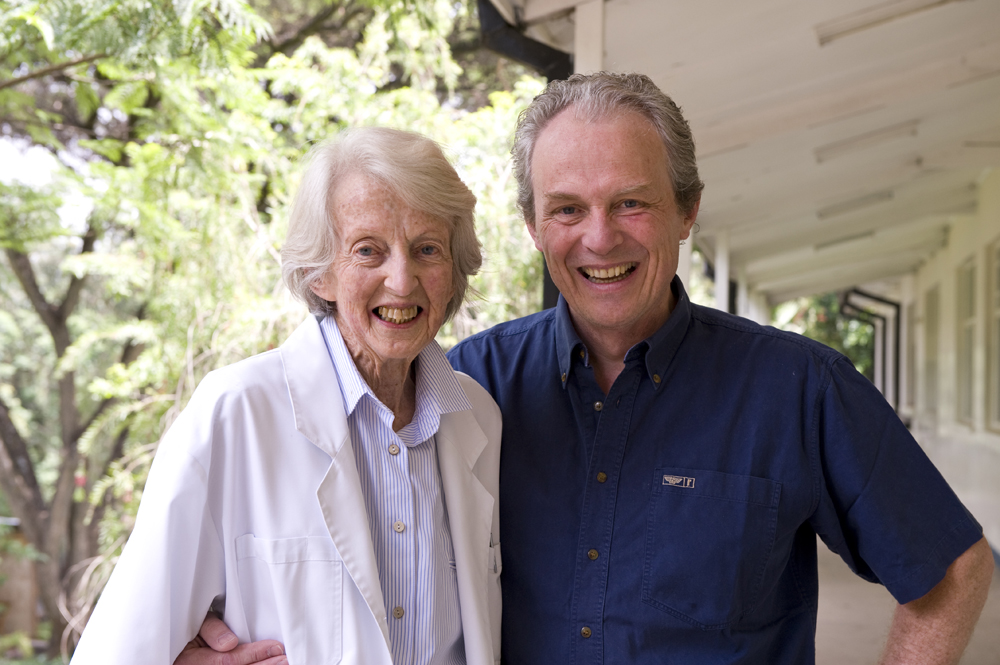
Catherine with her son Richard
Bio
Dr. Catherine Hamlin, AC, MBBS, FRCS, FRANZCOG, FRCOG. In 1946 Catherine Hamlin graduated in medicine at the University of Sydney. She met and married Dr. Reginald Hamlin when they were both senior medical officers at Crown Street Women’s Hospital in Sydney. In 1959, Reg and Catherine, with their six-year-old son Richard, accepted a three-year contract with the Ethiopian Government to work as obstetrician-gynaecologists to set up a midwifery school in Addis Ababa.
On the evening of their arrival in Ethiopia, a fellow gynaecologist told them, “The fistula patients will break your hearts.” The Hamlin’s had never seen an obstetric fistula case before and there was little or no treatment available in Ethiopia.
Initially working from the Princess Tsehai Memorial Hospital in Addis Ababa, Catherine and Reg refined the surgical technique to close obstetric fistula injuries, while continuing to treat a broad range of obstetric cases. Within the first three years, Reg and Catherine had operated on 300 fistula patients. As news of a cure spread, many more patients came seeking treatment.
In 1962, the Hamlin’s built a hostel in the grounds of the Princess Tsehai, using money donated from overseas. The Hamlin’s then worked for more than a decade to establish a fistula hospital, and in 1974, founded the Addis Ababa Fistula Hospital, the only medical centre in the world at that time dedicated exclusively to obstetric fistula repair.
Dr. Reg Hamlin worked at the hospital until he died in 1993. Since then, Catherine’s work for obstetric fistula sufferers in Ethiopia has continued uninterrupted for more than half a century, with more than 45,000 patients treated. Catherine has twice been nominated for the Nobel Peace Prize and has received numerous international awards and acknowledgements for her dedication and pioneering work. In 2009 she was awarded the ‘alternative Nobel Peace Prize’, the Right Livelihood Award, for her work and in 2012 was given Ethiopian Honorary citizenship.
You can read more about Catherine and Regs’ amazing work in two bestselling books: Hospital by the River by Dr Catherine Hamlin with Australian journalist John Little and Catherine’s Gift by John Little. Both titles are now available in a number of languages.
Awards & Recognition
1971 – Haile Selassie Humanitarian Prize and Medal
1983 – Member of the Order of Australia A.M.
1984 – ANZAC Peace Prize
1987 – Gold Medal of Merit, Order of St. Gregory the Great by Pope John Paul- Benemerenti Gold Medallist
1989 – Honorary Gold Medal, Royal College of Surgeons of England
1992 – Distinguished Service Award, American College of Obstetricians and Gynaecologists
1994 – Achievement Award Australia Day Awards
1995 – Companion of the Order of Australia A.C.
1996 – Zonta International Award, International Honorary Member
1998 – Rotary Award for World Understanding and Peace, Rotary International
1999 – Nominee, Nobel Peace Prize
2000 – Centenary Medal, The Order of Australia Association
2003 – Honorary Fellow, American College of Surgeons
2004 – National Living Treasure of Australia, National Trust of Australia
2004 – Best Practices in Global Health, Global Health Council
2005 – Honorary Fellow, Royal College of Surgeons of Edinburgh
2005 – Doctor of Medicine Honoris causa, University of Sydney
2006 – Doctorate of Law, Honoris causa, University of Dundee
2006 – Honorary Fellow of the Australian College of Educators
2009 – Gold Medal, World Association for Sexual Healthcare, Rotary International
2009 – Right Livelihood Award, Stockholm, Sweden
2010 – Honorary Doctorate, Addis Ababa University, Ethiopia
2010 – Lifetime Achievement Award, “People to People”, Ethiopia
2010 – Achievement Award, (International Women’s Day), President of Ethiopia
2012 – Honorary Ethiopian Citizenship, Prime Minister Meles Zenawi
2014 – Nominee, Nobel Peace Prize
2014 – Distinguished Surgeon Award Society of Gynecologic Surgeons (SGS)